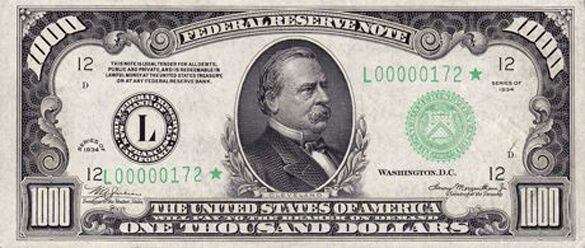
Living (and loving) Life
Did you know the U.S. used to have $1,000 bills in circulation?
Truth be told, we’ve even used larger bills than that in the past…
There was actually a time when the Federal Reserve issued $500, $5,000, $10,000 and even $100,000 bills (although the $100,000 bill was never used by the general population).
But that all changed in 1969 when the Federal government discontinued the use of all bills larger than a $100.
There are several reasons why the Feds decided to stop circulating those larger bills:
1 – If a really large bill were to be counterfeited and successfully passed, an unsuspecting victim could potentially lose his/her entire life’s savings in a single fraudulent transaction.
And yes, that actually happened many times back in the day.
2 – Really large bills would make it a lot easier for criminals to engage in illegal activities.
For example, if a drug kingpin were to sell $1,000,000 worth of illegal drugs to a distributor it would be a lot easier for them to conceal and carry ten $100,000 bills than ten-thousand $100 bills.
3 – It wasn’t cost-effective for the U.S. Treasury to print larger bills due to economy of scale.
Compared to the number of smaller bills, there were relatively few bills larger than $100 in circulation at any given time. That meant they only rarely needed to be printed, and in small numbers).
Since there’s a significant cost involved with printing bills of any specific denomination, it cost the government (and hence the taxpayers) a lot more money per bill to design and print those larger bills than the smaller ones we use today.
Bottom line: While it’s certainly true that larger bills could definitely come in handy at times, I believe the government made the right decision in pulling them out of circulation.
By the way, there are still some $1,000 bills out there because not all of the ones that were in circulation have been collected by the Feds.
If you happen to be lucky enough to find one you could still spend it just like any other bill, but I’m guessing you wouldn’t want to because it would actually be worth a lot more than its $1,000 face value if it’s genuine.
And now, to finish up, check out this short video that explains how the U.S. dollar came to be the basis of America’s money supply…
Note: As always, you can watch the video at full screen by clicking the “square” icon in the lower-right corner of the video after it begins playing.